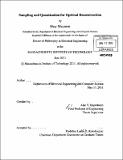Sampling and quantization for optimal reconstruction
Author(s)
Maymon, Shay
DownloadFull printable version (8.736Mb)
Other Contributors
Massachusetts Institute of Technology. Dept. of Electrical Engineering and Computer Science.
Advisor
Alan V. Oppenheim.
Terms of use
Metadata
Show full item recordAbstract
This thesis develops several approaches for signal sampling and reconstruction given different assumptions about the signal, the type of errors that occur, and the information available about the signal. The thesis first considers the effects of quantization in the environment of interleaved, oversampled multi-channel measurements with the potential of different quantization step size in each channel and varied timing offsets between channels. Considering sampling together with quantization in the digital representation of the continuous-time signal is shown to be advantageous. With uniform quantization and equal quantizer step size in each channel, the effective overall signal-to-noise ratio in the reconstructed output is shown to be maximized when the timing offsets between channels are identical, resulting in uniform sampling when the channels are interleaved. However, with different levels of accuracy in each channel, the choice of identical timing offsets between channels is in general not optimal, with better results often achievable with varied timing offsets corresponding to recurrent nonuniform sampling when the channels are interleaved. Similarly, it is shown that with varied timing offsets, equal quantization step size in each channel is in general not optimal, and a higher signal-to-quantization-noise ratio is often achievable with different levels of accuracy in the quantizers in different channels. Another aspect of this thesis considers nonuniform sampling in which the sampling grid is modeled as a perturbation of a uniform grid. Perfect reconstruction from these nonuniform samples is in general computationally difficult; as an alternative, this work presents a class of approximate reconstruction methods based on the use of time-invariant lowpass filtering, i.e., sinc interpolation. When the average sampling rate is less than the Nyquist rate, i.e., in sub-Nyquist sampling, the artifacts produced when these reconstruction methods are applied to the nonuniform samples can be preferable in certain applications to the aliasing artifacts, which occur in uniform sampling. The thesis also explores various approaches to avoiding aliasing in sampling. These approaches exploit additional information about the signal apart from its bandwidth and suggest using alternative pre-processing instead of the traditional linear time-invariant anti-aliasing filtering prior to sampling.
Description
Thesis (Ph. D.)--Massachusetts Institute of Technology, Dept. of Electrical Engineering and Computer Science, 2011. Cataloged from PDF version of thesis. Includes bibliographical references (p. 161-167).
Date issued
2011Department
Massachusetts Institute of Technology. Department of Electrical Engineering and Computer SciencePublisher
Massachusetts Institute of Technology
Keywords
Electrical Engineering and Computer Science.